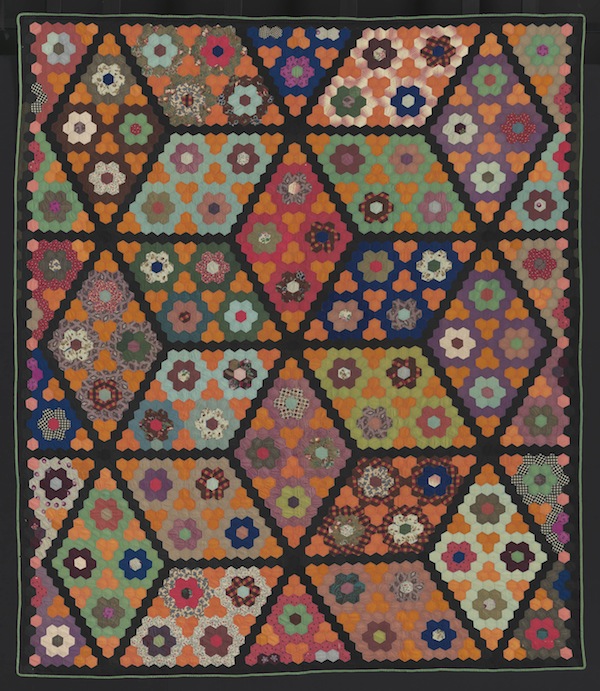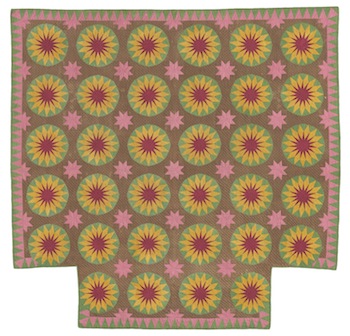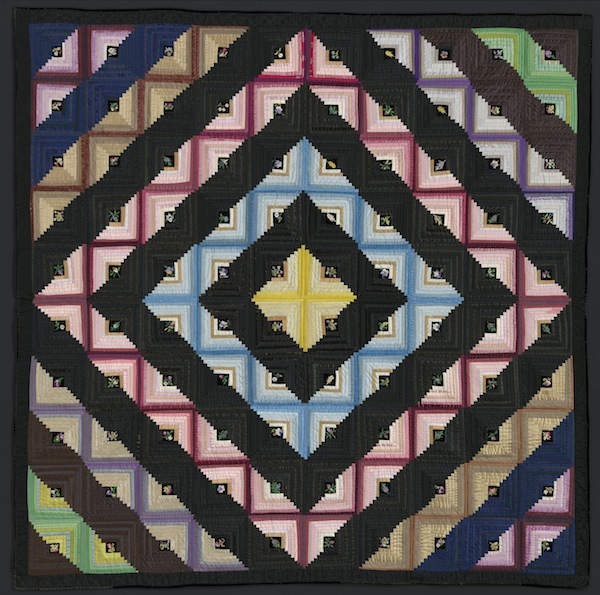Visual Arts Review: “Quilts and Color” — Far From Folk and Perhaps Beyond Art
Far from being the cool, detached, and cerebral creations of the color field artists, these quilts, imagined in their intended context, are deeply personal, sensuous, and alive.

Field of Diamonds Quilt. American, about 186o. Pieced wool plain weave and twill (some printed), glazed cotton plain weave back, wool plain weave binding; quilted. Pilgrim / Roy Collection. Photo: Museum of Fine Arts, Boston.
By Peter Walsh
When does a folk art become high art? The MFA’s Quilts and Color: The Pilgrim/Roy Collection (though July 27th) answers that question without really asking it. Then it raises another. Is “art” enough to describe a truly exceptional folk creation?
The sixty or so quilts on view in the exhibition, all from the private collection assembled by artist and designer Gerald Roy and his late partner Paul Pilgrim, hang like stunning artifacts rescued from a vanished civilization. Arranged flat, with lots of space, against dark walls, dramatically lit to heighten their eye-popping colors, the quilts look strikingly like paintings by the late 20th-century “color field” or “op art” artists—painters and printmakers who dazzled or tricked the eye with vibrating color combinations and repeating, abstract compositions. This is not accidental. The installation intersperses works by 20th-century color artists Victor Vasarely, Yaacov Agam, Bridget Riley, Sol Lewitt, and the influential artist, art educator, and color theorist Josef Albers, to drive home the point.
This curatorial tack is almost unadulterated “formalism,” following the critical theory, especially modish in the mid-1960s when the Pilgrim/Roy collection began. Formalism analyzes art only from what can be seen—color, style, and composition—leaving aside, by and large, such issues as the life or artistic intentions of the artist, the social or historical context in which the art was made, and anything else that doesn’t directly meet the eye.
Formalism, along with Albers’s teaching and color theories, helped those trained in them appreciate quilts for their aesthetic value alone. The people and groups who make quilts were less important. The show’s organizers assume women created the quilts, for example, but in the exhibition labels they appear only as ghosts or fragments, as an anonymous “maker” or as a name or part of a name: “Mrs. Herrick” “Florence Mae Hart Diehl (1864–1941),” or “M.G.M.” Arranged into sections like “Vibrations, “Mixtures,” “Harmony,” and “Contrast,” the show is, as its title suggests, mostly an essay on color and design, not folk traditions.
Roy’s label comments speak of each piece in terms of color theory. Certain color contrasts “vibrate,” others “harmonize” or suggest distance or space. Variations on traditional quilt patterns create innovative patterns of light and dark. This studio shop talk is less annoying than it might sound, partly because the dazzling effects of the quilts themselves are so obvious to any visitor. There are the subtle contrasts of pink, brown, and green in “Mrs. Ephraim Scott’s” Sunburst quilt of 1856, and the pink, purple, and dark blue patterns of a Thousand Pyramids quilt (c. 1930) from Holmes County, Ohio, which strongly suggests certain Paul Klee watercolors. Others, like a late Floating Bars quilt of c. 1940, majestic in its dark color harmonies and powerful simplicity, come very close to now-classic paintings created around the same time by artists like Albers and Mark Rothko. The pure visual delight of this show continues from beginning to end.

Sunburst Quilt. Mrs. Ephraim Scott (American) 1856. Pieced printed cotton plain weave top, printed cotton plain weave back and binding; quilted. Pilgrim / Roy Collection. Photo: Museum of Fine Arts, Boston
Still, these mostly anonymous “makers” do not entirely hide behind the show’s formalist framing. Seen close up, for example, the quilts are emphatically handmade. The virtuosic stitching, spilling across the surface in quilted whorls, fronds, and stylized flowers, adds a level of texture that would be more obvious on a bed than in a museum gallery. The rich surface mixture of fabrics—plaids, prints, and solids, silks, silk velvet, silk embroidery, cottons, and woolens—seems to cry out to be stroked and fondled. Some subtle variations in the formal patterns—strings of plaid patches along the edges of one Thousand Pyramid quilt, for example—suggest private meanings stitched in by their makers.
Far from being the cool, detached, and cerebral creations of the color field artists, these quilts, imagined in their intended context, are deeply personal, sensuous, and alive.
The Pilgrim Roy Collection apparently does not make up a comprehensive, historical survey of American quilts. The examples on view at the MFA were clearly chosen deliberately to fit a certain aesthetic. They are mostly square, based on standard patterns, and roughly similar in size. Missing are the “crazy quilts,” a late Victorian fad, sewn from random scraps and often embroidered, and the sometimes enormous figural narrative quilts that can be the collective creation of a whole community, commemorating a historical event or a town’s history. Only in later years did the collectors acquire examples of familiar botanical and other patterns based on a white ground.
The first works Roy and Pilgrim collected, and the stars of the show, were the creations of German- and Swiss-American Anabaptist women, Mennonite and Amish, who settled in Pennsylvania and the Midwest. Oddly, quilt making was not an established tradition in these communities. It only appeared in the last decades of the 19th century, perhaps influenced, a label suggests, by the quilts of Welsh and English immigrants who settled nearby.
By this time, many Anabaptists were trading their original German language for practical English. The more progressive Mennonites were moving away from farming to town life, where they founded schools and colleges. Aided by cheap, mass-produced commercial fabrics, which also freed women from the labor-intensive tasks of spinning and weaving, quilting became more of a genteel leisure pursuit.

Log Cabin, Barn Raising Variation Quilt, Mrs. Herrick, American, Massachusetts, 1879. Foundation pieced top of cotton and silk in variety of structures including silk velvet with silk embroidery, silk plain weave backing quilted to unknown material. Pilgrim / Roy Collection. Photo: Museum of Fine Arts, Boston.
The brilliant, virtuosic quilts that Roy and Pilgrim acquired at auctions and sales could only have been made for status and show, not practical use. They are all so pristine and unfaded they must have been saved for special occasions. What exactly did they mean to their creators and to the families that owned them? The show offers only a few tantalizing, mysterious clues.
On acquiring a particularly impressive Log Cabin, Barn Raising Variation quilt (the one by “Mrs. Herrick”), the collectors exclaimed: “This has nothing to do with staying warm. This is ART.” True enough, but in the context of these transcendent creations, art just might be too limiting a word.
Peter Walsh has worked for the Harvard Art Museums, the Museum of Fine Arts, Boston, Wellesley College, The Metropolitan Museum of Art, Dartmouth College, and the Boston Athenaeum, among other institutions. His reviews and articles on the visual arts have appeared in numerous publications and he has lectured widely in the United States and Europe. He has an international reputation as a scholar of museum studies and the history and theory of media.
Tagged: American, folk art, museum-of-fine-arts-boston, quilts

Peter Walsh got it!!!!
What a testiment to the contributions of these anonymous quiltmakers “ARTISTS” from the past.
Not just to be honored but to be recognized but by such a prestigious institution.
It has been such a positive journey and such a pleasure to work with all those at the MFA that contributed to this enormous effort.
Special thanks to Malcolm Rogers for being such a visionary and to Peter Walsh.
Gerald E. Roy — Pilgrim / Roy Collection
sounds like a lovely exhibit. reminds me, however distantly, of the exquisite quilting exhibited a few years back as “the quilts of gee’s bend”.